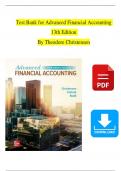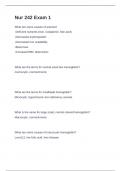Test Bank for Advanced Financial Accounting
13th Edition
By Theodore Christensen
,TEST BANK FOR
Advanced Financial Accounting 13th Edition By Theodore Christensen
Chapter 1 Intercorporate Acquisitions and Investments in Other Entities
1) Assuming no impairment in value prior to transfer, assets transferred by a parent company to
another entity it has created should be recorded by the newly created entity at the assets':
A) cost to the parent company.
B) book value on the parent company's books at the date of transfer.
C) fair value at the date of transfer.
D) fair value of consideration exchanged by the newly created entity.
Answer: B
Difficulty: 1 Easy
Topic: Internal Expansion: Creating a Business Entity; Valuation of Business Entities
Learning Objective: 01-01 Understand and explain the reasons for and different methods of
business expansion, the types of organizational structures, and the types of acquisitions.; 01-03
Make calculations and prepare journal entries for the creation of a business entity.
Bloom's: Remember
AACSB: Reflective Thinking
AICPA: FN Decision Making
2) Given the increased development of complex business structures, which of the following
regulators is responsible for the continued usefulness of accounting reports?
A) Securities and Exchange Commission (SEC)
B) Public Company Accounting Oversight Board (PCAOB)
C) Financial Accounting Standards Board (FASB)
D) All of the other answers are correct
Answer: D
Difficulty: 1 Easy
Topic: An Introduction to Complex Business Structures
Learning Objective: 01-01 Understand and explain the reasons for and different methods of
business expansion, the types of organizational structures, and the types of acquisitions.
Bloom's: Remember
AACSB: Reflective Thinking
AICPA: FN Reporting
3) A business combination in which the acquired company's assets and liabilities are combined
with those of the acquiring company into a single entity is defined as:
A) Stock acquisition
B) Leveraged buyout
C) Statutory Merger
D) Reverse statutory rollup
,Answer: C
Difficulty: 1 Easy
Topic: Organizational Structure and Financial Reporting
Learning Objective: 01-04 Understand and explain the differences between different forms of
business combinations.
Bloom's: Remember
AACSB: Reflective Thinking
AICPA: FN Decision Making
4) In which of the following situations do accounting standards not require that the financial
statements of the parent and subsidiary be consolidated?
A) A corporation creates a new 100 percent owned subsidiary
B) A corporation purchases 90 percent of the voting stock of another company
C) A corporation has both control and majority ownership of an unincorporated company
D) A corporation owns less-than a controlling interest in an unincorporated company
Answer: D
Difficulty: 1 Easy
Topic: Organizational Structure and Financial Reporting
Learning Objective: 01-01 Understand and explain the reasons for and different methods of
business expansion, the types of organizational structures, and the types of acquisitions.
Bloom's: Remember
AACSB: Reflective Thinking
AICPA: FN Decision Making
During its inception, Devon Company purchased land for $100,000 and a building for $180,000.
After exactly 3 years, it transferred these assets and cash of $50,000 to a newly created subsidiary,
Regan Company, in exchange for 15,000 shares of Regan's $10 par value stock. Devon uses
straight-line depreciation. Useful life for the building is 30 years, with zero residual value. An
appraisal revealed that the building has a fair value of $200,000.
5) Based on the information provided, at the time of the transfer, Regan Company should record:
A) Building at $180,000 and no accumulated depreciation.
B) Building at $162,000 and no accumulated depreciation.
C) Building at $200,000 and accumulated depreciation of $24,000.
D) Building at $180,000 and accumulated depreciation of $18,000.
Answer: D
Difficulty: 2 Medium
Topic: Valuation of Business Entities; Accounting for Internal Expansion: Creating Business
Entities
Learning Objective: 01-04 Understand and explain the differences between different forms of
business combinations.; 01-03 Make calculations and prepare journal entries for the creation of a
business entity.
Bloom's: Understand
AACSB: Analytical Thinking
AICPA: FN Measurement
,6) Based on the information provided, what amount would be reported by Devon Company as
investment in Regan Company common stock?
A) $312,000
B) $180,000
C) $330,000
D) $150,000
Answer: A
Difficulty: 2 Medium
Topic: Accounting for Internal Expansion: Creating Business Entities; The Development of
Accounting for Business Combinations
Learning Objective: 01-03 Make calculations and prepare journal entries for the creation of a
business entity.; 01-02 Understand the development of standards related to acquisition accounting
over time.
Bloom's: Understand
AACSB: Analytical Thinking
AICPA: FN Measurement
7) Based on the preceding information, Regan Company will report
A) additional paid-in capital of $0.
B) additional paid-in capital of $150,000.
C) additional paid-in capital of $162,000.
D) additional paid-in capital of $180,000.
Answer: C
Difficulty: 2 Medium
Topic: Accounting for Internal Expansion: Creating Business Entities
Learning Objective: 01-03 Make calculations and prepare journal entries for the creation of a
business entity.
Bloom's: Understand
AACSB: Analytical Thinking
AICPA: FN Measurement
At its inception, Peacock Company purchased land for $50,000 and a building for $220,000. After
exactly 4 years, it transferred these assets and cash of $75,000 to a newly created subsidiary,
Selvick Company, in exchange for 25,000 shares of Selvick's $5 par value stock. Peacock uses
straight-line depreciation. When purchased, the building had a useful life of 20 years with no
expected salvage value. An appraisal at the time of the transfer revealed that the building has a fair
value of $250,000.
8) Based on the information provided, at the time of the transfer, Selvick Company should record
A) the building at $220,000 and accumulated depreciation of $44,000.
B) the building at $220,000 with no accumulated depreciation.
C) the building at $176,000 with no accumulated depreciation.
D) the building at $250,000 with no accumulated depreciation.
,Answer: A
Difficulty: 2 Medium
Topic: Valuation of Business Entities; Accounting for Internal Expansion: Creating Business
Entities
Learning Objective: 01-04 Understand and explain the differences between different forms of
business combinations.; 01-03 Make calculations and prepare journal entries for the creation of a
business entity.
Bloom's: Understand
AACSB: Analytical Thinking
AICPA: FN Measurement
9) Based on the information provided, what amount would be reported by Peacock Company as
investment in Selvick Company common stock?
A) $125,000
B) $250,000
C) $301,000
D) $345,000
Answer: C
Difficulty: 2 Medium
Topic: Accounting for Internal Expansion: Creating Business Entities; The Development of
Accounting for Business Combinations
Learning Objective: 01-03 Make calculations and prepare journal entries for the creation of a
business entity.; 01-02 Understand the development of standards related to acquisition accounting
over time.
Bloom's: Understand
AACSB: Analytical Thinking
AICPA: FN Measurement
10) Based on the preceding information, Selvick Company will report additional paid-in capital of
A) $125,000.
B) $176,000.
C) $220,000.
D) $250,000.
Answer: B
Difficulty: 2 Medium
Topic: Accounting for Internal Expansion: Creating Business Entities
Learning Objective: 01-03 Make calculations and prepare journal entries for the creation of a
business entity.
Bloom's: Understand
AACSB: Analytical Thinking
AICPA: FN Measurement
11) Which of the following situations best describes a business combination to be accounted for as
a statutory merger?
A) Both companies in a combination continue to operate as separate, but related, legal entities.
,B) Only one of the combining companies survives and the other loses its separate identity.
C) Two companies combine to form a new third company, and the original two companies are
dissolved.
D) One company transfers assets to another company it has created.
Answer: B
Difficulty: 1 Easy
Topic: Legal Forms of Business Combinations
Learning Objective: 01-04 Understand and explain the differences between different forms of
business combinations.
Bloom's: Remember
AACSB: Reflective Thinking
AICPA: FN Decision Making
12) A statutory consolidation is a type of business combination in which:
A) One of the combining companies survives and the other loses its separate identity.
B) One company acquires the voting shares of the other company and the two companies continue
to operate as separate legal entities.
C) Two publicly traded companies agree to share a board of directors.
D) Each of the combining companies is dissolved and the net assets of both companies are
transferred to a newly created corporation.
Answer: D
Difficulty: 1 Easy
Topic: Legal Forms of Business Combinations
Learning Objective: 01-04 Understand and explain the differences between different forms of
business combinations.
Bloom's: Remember
AACSB: Reflective Thinking
AICPA: FN Decision Making
In order to reduce the risk associated with a new line of business, Conservative Corporation
established Spin Company as a wholly owned subsidiary. It transferred assets and accounts
payable to Spin in exchange for its common stock. Spin recorded the following entry when the
transaction occurred:
Cash and receivables 23,000
Inventory 15,000
Land 30,000
Buildings 100,000
Equipment 95,000
Accounts Payable 20,000
,Accumulated Depreciation—Buildings 32,000
Accumulated Depreciation—Equipment 30,000
Common Stock 56,000
Additional Paid-In Capital 125,000
13) Based on the preceding information, what number of shares of $7 par value stock did Spin
issue to Conservative?
A) 10,000
B) 7,000
C) 8,000
D) 25,000
Answer: C
Difficulty: 2 Medium
Topic: Combination Effected through Acquisition of Stock
Learning Objective: 01-05 Make calculations and business combination journal entries in the
presence of a differential, goodwill, or a bargain purchase element.
Bloom's: Understand
AACSB: Analytical Thinking
AICPA: FN Measurement
14) Based on the preceding information, what was the book value of Conservative's assets
transferred to Spin Company?
A) $243,000
B) $263,000
C) $221,000
D) $201,000
Answer: D
Difficulty: 2 Medium
Topic: Internal Expansion: Creating a Business Entity; Accounting for Internal Expansion:
Creating Business Entities
Learning Objective: 01-01 Understand and explain the reasons for and different methods of
business expansion, the types of organizational structures, and the types of acquisitions.; 01-03
Make calculations and prepare journal entries for the creation of a business entity.
Bloom's: Understand
AACSB: Analytical Thinking
AICPA: FN Measurement
15) Based on the preceding information, what amount did Conservative report as its investment in
Spin after the transfer of assets and liabilities?
A) $181,000
B) $221,000
C) $263,000
,D) $243,000
Answer: A
Difficulty: 2 Medium
Topic: Accounting for Internal Expansion: Creating Business Entities; The Development of
Accounting for Business Combinations
Learning Objective: 01-03 Make calculations and prepare journal entries for the creation of a
business entity.; 01-02 Understand the development of standards related to acquisition accounting
over time.
Bloom's: Understand
AACSB: Analytical Thinking
AICPA: FN Measurement
16) Based on the preceding information, immediately after the transfer,
A) Conservative's total assets decreased by $23,000.
B) Conservative's total assets decreased by $20,000.
C) Conservative's total assets increased by $56,000.
D) Conservative's total assets remained the same.
Answer: B
Difficulty: 2 Medium
Topic: Accounting for Internal Expansion: Creating Business Entities
Learning Objective: 01-03 Make calculations and prepare journal entries for the creation of a
business entity.
Bloom's: Understand
AACSB: Analytical Thinking
AICPA: FN Measurement
Rivendell Corporation and Foster Company merged as of January 1, 20X9. To effect the merger,
Rivendell paid finder's fees of $40,000, legal fees of $13,000, audit fees related to the stock
issuance of $10,000, stock registration fees of $5,000, and stock listing application fees of $4,000.
17) Based on the preceding information, under the acquisition method, what amount relating to the
business combination would be expensed?
A) $72,000
B) $19,000
C) $53,000
D) $63,000
Answer: C
Difficulty: 2 Medium
Topic: Applying the Acquisition Method
Learning Objective: 01-05 Make calculations and business combination journal entries in the
presence of a differential, goodwill, or a bargain purchase element.
Bloom's: Understand
AACSB: Analytical Thinking
AICPA: FN Measurement
,






